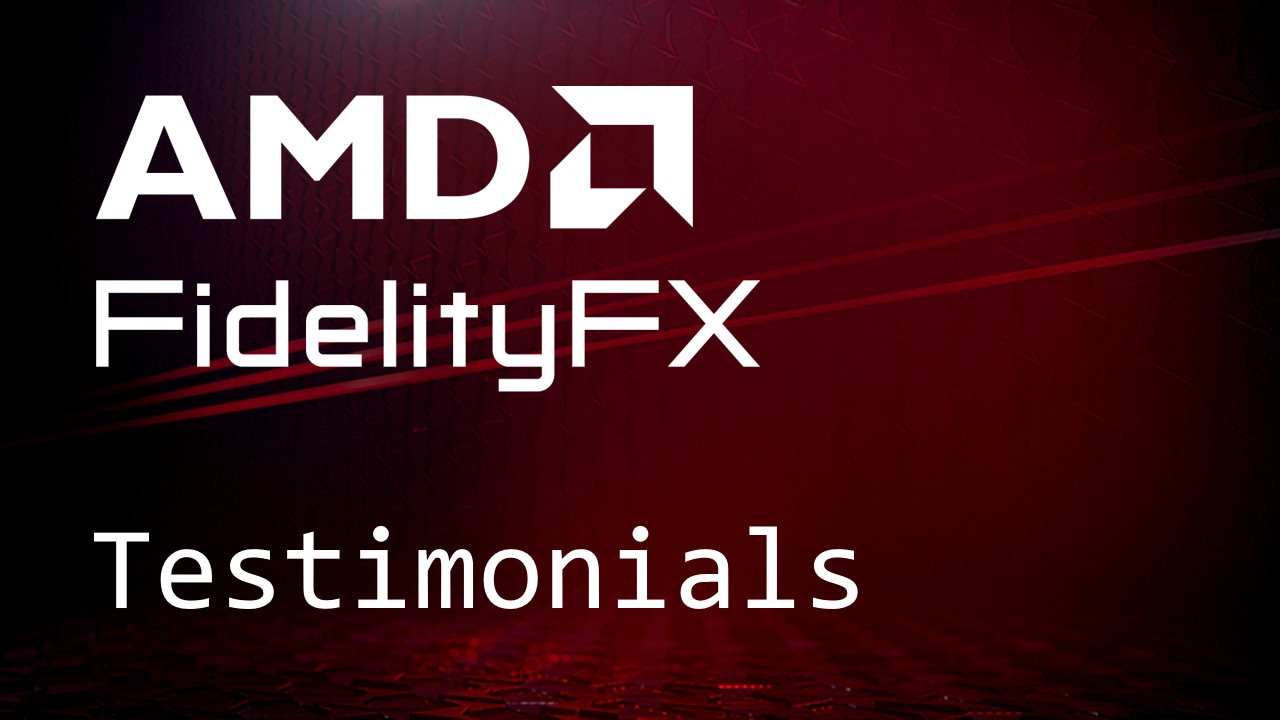
AMD FidelityFX™ – Testimonials
Find out what developers are saying about AMD FidelityFX.

Last update: 14th December 2023 to add the FSR 3 guidelines.
AMD FidelityFX™ is a suite of image quality-enhancing effects developed by AMD provided on GPUOpen under the MIT license. This page provides developers with a set of guidelines on how to present options in the game’s user interface to enable/disable FidelityFX effects.
Recommended naming
AMD recommends that “AMD FidelityFX” or “FidelityFX” be explicitly mentioned when such effects are referred to in a game, such as the game’s options screen. The name of the technique itself (or its acronym) may be substituted for an appropriate description of what the technique does.
These recommended naming guidelines do not constitute an explicit requirement. Developers integrating AMD FidelityFX effects in their titles may therefore choose to use alternative language based on their own preferences or requirements. FidelityFX effects that are not controlled by the game’s options screen need not be explicitly mentioned (e.g. FidelityFX SPD, Denoiser or Parallel sort would typically not require a user-selectable option).
For FidelityFX Super Resolution (FSR) guidelines, please use the separate FSR naming guidelines below. For all other FidelityFX effects, please see further down.
Alternative language variants for FSR descriptions are available with the language dropdown to the right of each table. Selecting a different language will modify all FSR descriptions to that language, not just those in the table.

| FSR 3 quality mode | Description |
|---|---|
| Native AA | Native AA mode provides an image quality superior to native rendering with a modest performance cost. |
| Quality | Quality mode provides an image quality equal or superior to native rendering with a significant performance gain. |
| Balanced | Balanced mode offers an ideal compromise between image quality and performance gains. |
| Performance | Performance mode provides an image quality similar to native rendering with a major performance gain. |
| Ultra Performance | Ultra Performance mode provides the highest performance gain while still maintaining an image quality representative of native rendering. |

| FSR 2 quality mode | Description |
|---|---|
| Quality | Quality mode provides an image quality equal or superior to native rendering with a significant performance gain. |
| Balanced | Balanced mode offers an ideal compromise between image quality and performance gains. |
| Performance | Performance mode provides an image quality similar to native rendering with a major performance gain. |
| Ultra Performance | Ultra Performance mode provides the highest performance gain while still maintaining an image quality representative of native rendering. |
If the game supports Dynamic Resolution Scaling is it recommended to add a “Dynamic” preset in the FSR 2 quality mode UI menu as the trigger to enable this mode.
These should replace any FSR 2.0 logos you are currently using, as these just show FSR 2.

| FSR 1 quality mode | Description |
|---|---|
| Ultra Quality | Ultra Quality mode produces an image with quality virtually indistinguishable from native rendering. It should be selected when the highest quality is desired. |
| Quality | Quality mode produces a super resolution image with quality representative of native rendering, with a sizeable performance gain. |
| Balanced | Balanced mode produces a super resolution image approximating native rendering quality, with a major performance gain compared to native. |
| Performance | Performance mode visibly impacts image quality and should only be selected in situations where needing additional performance is critical. |
Please list FSR quality presets from highest to lowest quality. An example is shown below:

FSR 1 applied on a non anti-aliased input image will likely return poor results. Hard edges will be detected as such and exacerbated in the upscaled image.
To avoid this situation please implement either of the following options:
FSR 1 comes with its own sharpening pass. If your game already supports a sharpening option in the UI please gray out sharpening UI when FSR 1 is enabled. This is to avoid a clash with the RCAS sharpening feature of FSR 1.
Please do not use FSR 1 RCAS without EASU upscaling. If sharpening is desired without FSR 1 upscaling, then FidelityFX CAS is recommended instead.
These are available further down.
If the game offers support for both FSR 1 and FSR 2, it might be helpful to adjust the UI descriptions text to provide additional guidance to users:
Please connect the sharpening value set in any exposed slider to the upscaling technique used. Note that the sharpening value has a different effect between FSR 1 and FSR 2 and remapping will therefore be required.

Language English Español Français Deutsch Italiano Português (Brazil) Polski 日本語 한국어 中文 – 简体 中文 – 繁體
For FidelityFX Super Resolution (FSR) guidelines, please use the separate FSR naming guidelines further up.
| “AMD FidelityFX Sharpening” | “FidelityFX Sharpening” |
| “AMD FidelityFX Upsampling and Sharpening” | “FidelityFX Upsampling and Sharpening” |
| “AMD FidelityFX Contrast Adaptive Sharpening” | “FidelityFX Contrast Adaptive Sharpening” |
| “AMD FidelityFX CAS” | “FidelityFX CAS” |
| Sharpening: [Off], [AMD FidelityFX], […] | Sharpening: [Off], [FidelityFX], […] |
| Upscaling: [Off], [AMD FidelityFX], […] | Upscaling: [Off], [FidelityFX], […] |
| “CAS” |
| “GPUOpen CAS” |
| “AMD CAS” |
| “Contrast Adaptive Sharpening” |
| Sharpening: [Off], [CAS], […] |
| Upscaling: [Off], [CAS], […] |
| “FidelityFX” |
If desired, the developer may opt to include the AMD FidelityFX/FidelityFX Super Resolution banner in the game’s splash screen and/or other suitable locations (description in the game options screen, credits, “about” page etc.)
If this option is chosen, then the banner files linked on the page below and the term “AMD FidelityFX” or “FidelityFX” may be omitted from the option screen when referring to the enablement of these techniques.
AMD_FidelityFX_Lockup_Black_RGB.eps ” or “ AMD_FidelityFX_Lockup_Black_RGB.png ”AMD_FidelityFX_Lockup_Reversed_RGB.eps ” or “ AMD_FidelityFX_Lockup_Reversed_RGB.png ”AMD_FidelityFX_Super_Resolution_Lockup_RGB_Blk.eps ” or “ AMD_FidelityFX_Super_Resolution_Lockup_RGB_Blk.png ”AMD_FidelityFX_Super_Resolution_Lockup_RGB_Wht.eps ” or “ AMD_FidelityFX_Super_Resolution_Lockup_RGB_Wht.png ”